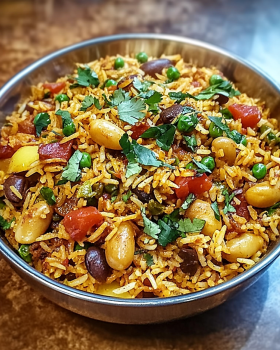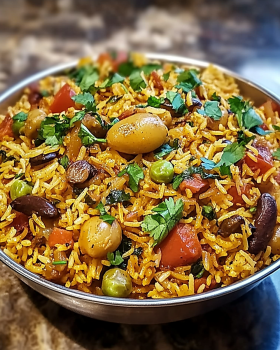Introduction to Spring Vegan Biryani
What is Spring Vegan Biryani?
Spring Vegan Biryani is a delightful and colorful dish that celebrates the fresh flavors of spring. This vegan version of the traditional biryani is packed with vibrant vegetables and aromatic spices. It’s a one-pot meal that combines basmati rice with chickpeas, peas, and a medley of seasonal veggies. The result is a hearty, nutritious dish that is both satisfying and easy to prepare. Perfect for family dinners or gatherings, this biryani is sure to impress everyone at the table.
The Origins of Biryani
Biryani has a rich history that dates back centuries. It is believed to have originated in Persia and was brought to India by the Mughals. Traditionally, biryani is made with meat, rice, and a variety of spices, cooked together to create a flavorful dish. Over time, many regional variations emerged, each with its unique twist. Today, biryani is enjoyed worldwide, and the vegan version allows everyone to savor its deliciousness without compromising dietary choices. The Spring Vegan Biryani pays homage to this classic dish while embracing the fresh, seasonal ingredients that spring offers.
Ingredients for Spring Vegan Biryani
Essential Ingredients
To create a delicious Spring Vegan Biryani, you’ll need a variety of essential ingredients. These components not only provide flavor but also contribute to the dish’s vibrant colors and textures. Here’s what you’ll need:
- Basmati Rice: 2 cups of this fragrant rice is the base of your biryani.
- Chickpeas: One can (15 ounces) of chickpeas adds protein and heartiness.
- Onion: A medium onion, thinly sliced, brings sweetness and depth.
- Garlic and Ginger: Two cloves of garlic and one tablespoon of fresh ginger enhance the aroma.
- Green Peas: One cup of peas, either fresh or frozen, adds a pop of color.
- Carrot and Bell Pepper: A large diced carrot and a diced red bell pepper provide crunch and sweetness.
- Vegetable Broth: One cup of broth infuses the rice with flavor.
- Diced Tomatoes: One can (14.5 ounces) of diced tomatoes adds moisture and tang.
- Olive Oil: Two tablespoons for sautéing the vegetables.
- Spices: Curry powder, cumin, and turmeric are essential for that authentic biryani flavor.
- Salt and Pepper: To taste, enhancing all the flavors.
- Cilantro: Fresh cilantro for garnish adds a refreshing touch.
Optional Ingredients for Customization
One of the best things about Spring Vegan Biryani is its versatility. You can easily customize it based on your preferences or what you have on hand. Here are some optional ingredients to consider:
- Saffron: A pinch of saffron soaked in warm water can elevate the dish with its unique flavor and color.
- Seasonal Vegetables: Feel free to add zucchini, cauliflower, or spinach for extra nutrition and variety.
- Nuts and Dried Fruits: Cashews or raisins can add a delightful crunch and sweetness.
- Spicy Peppers: For those who enjoy heat, adding chopped green chilies can spice things up.
With these essential and optional ingredients, you can create a Spring Vegan Biryani that is not only delicious but also tailored to your taste. Enjoy the process of making this dish, and don’t hesitate to experiment with different flavors!
Preparation of Spring Vegan Biryani
Step 1: Preparing the Vegetables
To start your Spring Vegan Biryani, the first step is to prepare the vegetables. Begin by washing and peeling the carrot. Then, dice it into small pieces. Next, take the red bell pepper, remove the seeds, and chop it into bite-sized cubes. For the onion, slice it thinly to ensure it cooks evenly. Lastly, if you’re using fresh peas, shell them and set them aside. Having all your vegetables prepped will make the cooking process smoother and more enjoyable.
Step 2: Cooking the Rice
Cooking the basmati rice is crucial for achieving the perfect texture in your biryani. Rinse the rice under cold water until the water runs clear. This step removes excess starch, preventing the rice from becoming sticky. After rinsing, soak the rice in water for about 30 minutes. This soaking time allows the grains to absorb water, ensuring they cook evenly. Once soaked, drain the rice and set it aside for later use.
Step 3: Sautéing the Spices
Now it’s time to bring out the flavors! In a large pot, heat two tablespoons of olive oil over medium heat. Once the oil is hot, add the sliced onion. Sauté the onion for about five minutes until it becomes translucent. Then, stir in the minced garlic and grated ginger. Cook these ingredients for an additional minute, allowing their aromas to fill your kitchen. This step is essential as it forms the flavor base for your biryani.
Step 4: Combining Ingredients
After sautéing the onions, garlic, and ginger, it’s time to add the diced carrot and bell pepper. Cook these vegetables for about three to four minutes until they start to soften. Next, sprinkle in the curry powder, cumin, and turmeric. Stir the spices for one minute to release their flavors. Then, add the drained chickpeas, green peas, diced tomatoes (with their juice), and vegetable broth. Season the mixture with salt and pepper to taste. Bring everything to a gentle simmer, allowing the flavors to meld together.
Step 5: Final Cooking Process
Now comes the exciting part! Gently fold in the soaked and drained basmati rice, ensuring it is evenly distributed throughout the pot. Cover the pot with a lid and reduce the heat to low. Let the biryani cook for 20 minutes without lifting the lid. This step is crucial as it allows the rice to absorb all the delicious flavors. After 20 minutes, remove the pot from heat and let it sit, covered, for an additional 10 minutes. This resting time helps the rice steam perfectly. Finally, fluff the biryani with a fork and garnish with fresh cilantro before serving. Enjoy your vibrant and flavorful Spring Vegan Biryani!

Variations of Spring Vegan Biryani
Different Vegetable Combinations
One of the most delightful aspects of Spring Vegan Biryani is its adaptability. You can easily switch up the vegetables based on what’s in season or what you have in your kitchen. For instance, if you want to add more greens, consider including spinach or kale. These leafy vegetables not only boost the nutritional value but also add a lovely color to your dish.
Another great option is to incorporate zucchini or cauliflower. These vegetables absorb flavors beautifully and provide a satisfying texture. If you enjoy a bit of crunch, try adding some diced bell peppers or even snap peas. The key is to mix and match according to your taste preferences. This flexibility allows you to create a unique biryani every time you make it!
Alternative Grains for Biryani
While basmati rice is the traditional choice for biryani, you can experiment with other grains to suit your dietary needs or preferences. Quinoa is a fantastic alternative, offering a nutty flavor and extra protein. It cooks quickly and can be a great gluten-free option. Another choice is farro, which has a chewy texture and adds a hearty element to your dish.
If you’re looking for something different, try using brown rice. It has a slightly earthy taste and is more nutritious than white rice. Just keep in mind that brown rice may require a longer cooking time. By exploring these alternative grains, you can enjoy a delicious Spring Vegan Biryani that fits your lifestyle while still being full of flavor!
Cooking Note for Spring Vegan Biryani
Tips for Perfectly Cooked Rice
Cooking rice perfectly is essential for a delicious Spring Vegan Biryani. Here are some tips to ensure your rice turns out fluffy and flavorful:
- Rinse Thoroughly: Always rinse the basmati rice under cold water until the water runs clear. This step removes excess starch, preventing the rice from becoming gummy.
- Soak the Rice: Soaking the rice for at least 30 minutes helps the grains absorb water. This ensures even cooking and a better texture.
- Water Ratio: Use the right water-to-rice ratio. For basmati rice, a common ratio is 1 cup of rice to 1.5 cups of liquid. Adjust based on the type of rice you use.
- Don’t Lift the Lid: Once you cover the pot, resist the urge to lift the lid while cooking. This keeps the steam trapped, allowing the rice to cook evenly.
- Let it Rest: After cooking, let the biryani sit covered for an additional 10 minutes. This resting period allows the rice to steam and become fluffy.
By following these tips, you can achieve perfectly cooked rice that enhances the overall taste and texture of your Spring Vegan Biryani.
Adjusting Spice Levels
Spice levels can make or break a dish, especially in a flavorful recipe like Spring Vegan Biryani. Here are some ways to adjust the spice levels to suit your taste:
- Start Mild: If you’re unsure about spice levels, start with a smaller amount of curry powder and cumin. You can always add more later if needed.
- Fresh Peppers: For those who enjoy heat, consider adding fresh green chilies. Slice them and add them during the sautéing process for a spicy kick.
- Chili Powder: If you want to increase the heat, sprinkle in some chili powder or cayenne pepper. Start with a pinch and adjust according to your preference.
- Cooling Ingredients: If your biryani turns out too spicy, add a dollop of coconut yogurt or serve it with a side of raita. These cooling ingredients can balance the heat.
- Herbs and Citrus: Fresh herbs like cilantro or a squeeze of lemon juice can also help tone down the spice while adding freshness.
By adjusting the spice levels, you can create a Spring Vegan Biryani that is just right for you and your guests. Enjoy experimenting with flavors!
Serving Suggestions for Spring Vegan Biryani
Accompaniments to Enhance Flavor
To elevate your Spring Vegan Biryani experience, consider serving it with a variety of delicious accompaniments. These side dishes not only enhance the flavors but also add a delightful contrast to the biryani. Here are some popular options:
- Raita: A cooling yogurt-based side dish, raita is perfect for balancing the spices in biryani. You can make a simple cucumber raita by mixing diced cucumber, yogurt, and a sprinkle of cumin.
- Pickles: Indian pickles, or “achar,” add a tangy kick to your meal. They come in various flavors, from spicy to sweet, and can complement the biryani beautifully.
- Salad: A fresh salad made with cucumbers, tomatoes, and onions can provide a refreshing crunch. Drizzle with lemon juice for added zest.
- Chutney: Serve your biryani with a side of mint or coriander chutney. These vibrant sauces add a burst of flavor and freshness.
- Papadums: Crispy papadums are a great addition. They add texture and can be enjoyed as a crunchy side or topping.
These accompaniments will not only enhance the flavor of your Spring Vegan Biryani but also create a well-rounded meal that everyone will enjoy.
Presentation Ideas
Presentation plays a key role in making your Spring Vegan Biryani visually appealing. Here are some creative ideas to serve your dish:
- Layered Serving: For a stunning presentation, layer the biryani in a large serving dish. Start with a base of rice, then add a layer of vegetables and chickpeas, followed by another layer of rice. Top with fresh cilantro and a sprinkle of spices.
- Individual Bowls: Serve the biryani in individual bowls for a personal touch. Garnish each bowl with cilantro and a slice of lemon for a pop of color.
- Garnish: Use fresh herbs like cilantro or mint to garnish the biryani. You can also add toasted nuts or seeds for an extra crunch.
- Colorful Plates: Choose vibrant plates that contrast with the colors of the biryani. This will make the dish stand out even more.
- Accompaniment Arrangement: Arrange your accompaniments in small bowls around the biryani. This not only looks appealing but also invites guests to mix and match flavors.
With these serving suggestions and presentation ideas, your Spring Vegan Biryani will not only taste amazing but also look stunning on the table. Enjoy sharing this delightful dish with family and friends!
Tips for Making the Best Spring Vegan Biryani
Common Mistakes to Avoid
Making the perfect Spring Vegan Biryani can be a delightful experience, but there are some common mistakes to watch out for. Here are a few tips to help you avoid pitfalls:
- Overcooking the Rice: One of the biggest mistakes is overcooking the rice. This can lead to mushy biryani. Always follow the cooking times and let the rice rest after cooking.
- Skipping the Soaking Step: Rinsing and soaking the basmati rice is crucial. Skipping this step can result in sticky rice. Always rinse until the water runs clear and soak for at least 30 minutes.
- Not Seasoning Enough: Under-seasoning can make your biryani bland. Taste as you go and adjust the salt and spices to enhance the flavors.
- Using Cold Ingredients: Adding cold vegetables or broth can lower the cooking temperature. Make sure your ingredients are at room temperature for even cooking.
- Neglecting to Fluff: After cooking, don’t forget to fluff the rice gently with a fork. This helps separate the grains and improves the texture.
By avoiding these common mistakes, you can ensure that your Spring Vegan Biryani turns out delicious and satisfying every time!
Storage Tips for Leftovers
If you have leftovers from your Spring Vegan Biryani, storing them properly is essential to maintain freshness. Here are some helpful storage tips:
- Cool Before Storing: Allow the biryani to cool to room temperature before placing it in the refrigerator. This helps prevent condensation and sogginess.
- Use Airtight Containers: Store the biryani in airtight containers to keep it fresh. This prevents moisture from getting in and helps retain flavor.
- Refrigerate Promptly: Make sure to refrigerate leftovers within two hours of cooking. This helps prevent bacterial growth.
- Reheat Gently: When reheating, add a splash of water or broth to keep the rice moist. Heat it on low in a pot or microwave, stirring occasionally.
- Consume Within a Few Days: For the best taste and quality, try to eat the leftovers within 3-4 days. If you want to keep them longer, consider freezing portions.
By following these storage tips, you can enjoy your Spring Vegan Biryani even after the initial meal, ensuring it remains delicious and satisfying!
Breakdown of Time for Spring Vegan Biryani
Prep Time
Preparing your ingredients is an important step in making Spring Vegan Biryani. The prep time typically takes about 15 to 20 minutes. During this time, you will wash and chop the vegetables, rinse and soak the basmati rice, and gather all your spices and other ingredients. Having everything ready before you start cooking will make the process smoother and more enjoyable.
Cooking Time
The cooking time for Spring Vegan Biryani is approximately 30 minutes. This includes sautéing the vegetables and spices, simmering the chickpeas and tomatoes, and finally cooking the rice. It’s essential to keep the pot covered during the cooking process to trap the steam, which helps the rice cook evenly. Remember, patience is key here!
Total Time
In total, you can expect to spend about 50 to 60 minutes from start to finish when making Spring Vegan Biryani. This includes both the prep and cooking times. It’s a relatively quick meal to prepare, especially considering how flavorful and satisfying it is. Whether you’re cooking for a family dinner or meal prepping for the week, this time investment is well worth it!
Nutritional Information for Spring Vegan Biryani
Calories and Macronutrients
Understanding the nutritional content of your meals is essential for maintaining a balanced diet. Each serving of Spring Vegan Biryani offers a delightful combination of flavors and nutrients. Here’s a breakdown of the calories and macronutrients per serving:
- Calories: 320
- Net Carbohydrates: 50g
- Protein: 10g
- Fat: 8g
This nutritional profile makes Spring Vegan Biryani a wholesome option for lunch or dinner. The combination of basmati rice and chickpeas provides a good source of carbohydrates and protein, while the vegetables contribute essential vitamins and minerals. Enjoying this dish can help you feel satisfied and energized throughout the day!
Health Benefits of Ingredients
Spring Vegan Biryani is not only delicious but also packed with health benefits thanks to its wholesome ingredients. Here are some of the key health benefits:
- Basmati Rice: This fragrant rice is low in fat and has a low glycemic index, making it a great choice for maintaining stable blood sugar levels.
- Chickpeas: Rich in protein and fiber, chickpeas help keep you full longer and support digestive health. They are also a good source of iron and folate.
- Vegetables: The colorful mix of carrots, bell peppers, and peas provides a variety of vitamins, such as vitamin A, C, and K. These nutrients are essential for immune function and skin health.
- Spices: Turmeric, cumin, and curry powder not only add flavor but also have anti-inflammatory properties. Turmeric, in particular, contains curcumin, which is known for its health benefits.
- Olive Oil: A healthy fat, olive oil is rich in monounsaturated fats and antioxidants. It supports heart health and can help reduce inflammation.
By incorporating these nutritious ingredients, Spring Vegan Biryani becomes a meal that nourishes your body while delighting your taste buds. Enjoy this vibrant dish knowing that it contributes to your overall health!

FAQs about Spring Vegan Biryani
Can I make Spring Vegan Biryani ahead of time?
Absolutely! Spring Vegan Biryani is a great dish to prepare ahead of time. You can make it a day in advance and store it in the refrigerator. Just make sure to let it cool completely before transferring it to an airtight container. When you’re ready to serve, simply reheat it on the stove or in the microwave. Adding a splash of vegetable broth or water while reheating can help keep the rice moist and fluffy. This makes it a perfect option for meal prep or for hosting gatherings!
What can I substitute for rice in Spring Vegan Biryani?
If you’re looking for alternatives to rice in your Spring Vegan Biryani, there are several options to consider. Quinoa is a popular choice, as it cooks quickly and adds a nutty flavor. Another great substitute is cauliflower rice, which is low in carbs and adds a unique texture. You can also use farro or barley for a heartier option. Just keep in mind that cooking times may vary, so adjust accordingly. These alternatives can provide a delightful twist to your biryani while still being delicious!
Is Spring Vegan Biryani gluten-free?
Yes, Spring Vegan Biryani is naturally gluten-free! The main ingredients, such as basmati rice, chickpeas, and vegetables, do not contain gluten. However, if you choose to use alternative grains, like farro or barley, be sure to check their labels for gluten content. Additionally, always ensure that any spices or packaged ingredients you use are certified gluten-free to avoid cross-contamination. This makes it a wonderful option for those with gluten sensitivities or celiac disease!
How can I make Spring Vegan Biryani spicier?
If you love a bit of heat in your dishes, there are several ways to spice up your Spring Vegan Biryani. Start by adding fresh green chilies during the sautéing process. You can also increase the amount of curry powder or add a pinch of cayenne pepper for an extra kick. Another option is to include spicy pickles or serve the biryani with a spicy chutney on the side. Just remember to taste as you go, so you can adjust the spice levels to your liking. Enjoy experimenting with flavors!
Conclusion on Spring Vegan Biryani
Recap of the Recipe
In summary, Spring Vegan Biryani is a vibrant and nutritious dish that brings together the best of seasonal vegetables and aromatic spices. With its base of fluffy basmati rice and hearty chickpeas, this one-pot meal is not only satisfying but also easy to prepare. The recipe guides you through each step, from preparing the vegetables to cooking the rice and combining all the flavors. With a cooking time of just about 30 minutes, you can enjoy a delicious meal that is perfect for family dinners or gatherings with friends. Plus, the nutritional benefits make it a wholesome choice for any occasion.
Encouragement to Experiment with Ingredients
As you embark on your culinary journey with Spring Vegan Biryani, don’t hesitate to experiment with different ingredients. The beauty of this dish lies in its versatility. You can swap out vegetables based on what’s in season or add your favorite spices to create a unique flavor profile. Whether you choose to include saffron for a touch of luxury or add extra greens for a nutritional boost, the possibilities are endless. Enjoy the process of making this dish, and let your creativity shine in the kitchen. Happy cooking!



